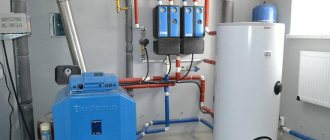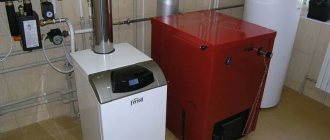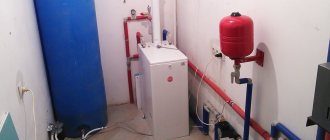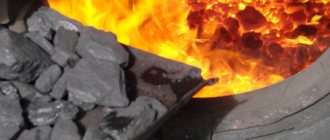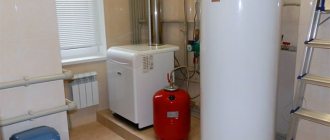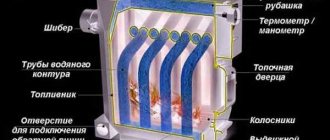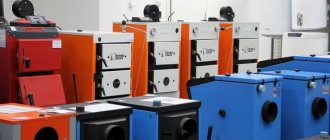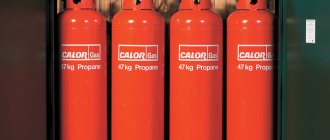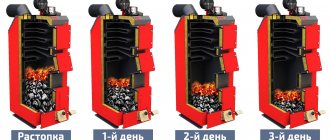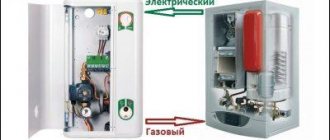When building a country house, heating organization becomes an important point. If there is no main gas pipeline, a diesel heating boiler for a private home will help solve the problem.
Diesel boiler - an alternative to gas heating Source nehomesdeaf.org
Features of using liquid fuel boilers
A diesel boiler installed to heat a private home has many advantages compared to other heating systems. The obvious advantages include the following factors:
- the boiler functioning process is automated, it is regulated based on the temperature of the coolant;
- high efficiency of up to 85-95%;
- direct connection of diesel equipment does not require complex approvals from various authorities;
- installation of diesel equipment is quick;
- supplying fuel for the boiler is not difficult;
- smoke exhaust can be organized through the wall;
- affordable price for equipment.
The disadvantages include:
- high fuel consumption and a significant price for it;
- for a constant supply of diesel fuel, a storage system must be organized and connected to the boiler;
- energy dependence;
- the need to place the boiler in a boiler room, a dedicated separate room;
- the need to organize a backup source of power supply.
Organizing diesel heating will require more costs Source strojdvor.ru
Advantages and disadvantages of the oven
Advantages of the stove:
- absence of harmful gases and fumes during operation;
- safety - a working stove can be left unattended;
- low fuel consumption during operation (due to high density);
- efficiency;
- the possibility of adding biological fuel (vegetable oil, for example) to diesel fuel; ease of transportation;
- Possibility of using the top for cooking.
There are not many disadvantages - the cost of diesel fuel directly depends on world prices for crude oil. If you plan to build a diesel stove with your own hands, then the principle of its operation will be similar to that described above. But first, a little about fire safety.
Equipment classification
Depending on the requirements for the equipment, a specific boiler model is selected. Characteristics that are important when selecting a heating boiler:
- power;
- combustion type;
- heat exchanger material;
- fuel consumption;
- additional possibility of heating water.
Inside view of an oil-fuel boiler Source stroyfora.ru
See also: Catalog of companies that specialize in insulating houses.
Power
The efficiency of diesel fuel consumption and the operating efficiency of the unit depend on the power consumption. The generally accepted unit of power measurement is kilowatt. This characteristic must be reflected in the documentation supplied with the boiler.
The selection of a model based on power must be made based on the area of the heated room of the house. Calculating the required power is quite simple: sum up the area of all rooms, and the resulting amount must be divided by 10. This formula is used to determine the power of a boiler for a house located in a temperate climate.
This calculation method is suitable for rooms in which the ceiling height is no more than 3 m. If the building is located in an area with a cold climate, then the calculated power of the unit must be increased in the range from 20 to 30%.
Comparison of the power of boilers of different types in the table Source pechilux.ru
Determination of fuel consumption
Diesel heating of a private home requires significant consumption of diesel fuel. This indicator depends on the power of the boiler equipment. The amount of fuel can be calculated using the formula: divide the boiler power by 10. The resulting quotient is the hourly fuel consumption (in kilograms) during heating.
In temperature maintenance mode, fuel consumption is significantly reduced. How economically diesel fuel will be consumed depends on the quality of the building’s thermal insulation. If it is weak, the flow rate will decrease by a third; if it is good, it will decrease by up to 70%. The average fuel consumption for a private home is usually from 500 to 900 grams.
Boilers for heating and heating
Diesel boilers can be used not only to heat a house, but also to heat water. Devices that combine both of these functions are called dual-circuit.
If this is the option you need, the calculated power must be increased by a fifth. This factor must be taken into account immediately. Otherwise, the power of the diesel boiler may not be enough for both water heating and heating.
Heating system for heating a house and heating water Source teplotehnika.msk.ru
Heat exchanger: choice of material of manufacture
The boiler heat exchanger material is one of the important parameters. During fuel combustion, soot is formed, which, when combined with condensate, leads to corrosion and failure of the unit. Each heat exchanger material has its own strengths and weaknesses, including resistance to corrosion and temperature changes.
Cast iron
A heat exchanger made of cast iron has higher corrosion resistance compared to steel. But at the same time it can crack due to temperature changes. Cast iron is heavier than steel and its price is higher.
Steel
The steel body is lighter and cheaper than cast iron, it is resistant to temperature changes, but is susceptible to corrosion. Stainless steel has the best performance qualities. But such a boiler will cost more.
When choosing a diesel boiler, you can start from financial capabilities, but do not forget about the quality and duration of operation Source happymodern.ru
DIY diesel stove
Today, the main problem of summer cottages remote from big cities is the lack of sufficient energy resources.
Sometimes people find it difficult to even find dry wood, while connection to substations is planned in the very distant future. In such cases, the best option may be a homemade diesel stove. It is used mainly in those rooms where the use of other types of heating is impossible for one reason or another. The main thing is that these rooms are well ventilated.
The good thing about a homemade device is that the owner of a room that needs to be heated, knowing his own needs, can make a stove that ideally meets the expected operating conditions. It will be both more efficient and more economical.
Keeping in mind safety requirements, a homemade diesel stove can, in principle, be built under one of the following schemes:
- Double-circuit gas-air;
- Wick;
- Drip.
Dripper stove made from a gas cylinder
A used gas (carbon or oxygen) cylinder can serve as the main one for making a furnace.
The fuel will flow by gravity, and forced air supply is not needed with this design. Heating of the cylinder to fire hazardous temperatures must be prevented by setting the height of the device contour according to the height of the combustion source located inside.
Pay attention to the thickness of the walls of the cylinder. We need flammable fuel vapors to form. If the walls are thicker, the temperature required for boiling will not be reached.
On the street, you should drain the condensation from the container and rinse the container a couple of times with water so that there is no odorant left in it. Then it is filled with water to the top and buried in the ground for stability. Use a grinder to cut off the top part of the cylinder with the valve.
Attention should be paid to the fact that the chimney must be vertical without angles or slopes. The length of the chimney pipe itself should not be less than 4 meters.
Mining can also be poured into this structure, but only after its preliminary cleaning. If the oil is unrefined, it may contain water or alcohol. Then when heated there is a danger of explosion and fire.
Fuel is poured into 2/3 of the tank. A lit sheet of paper is placed on top of the diesel fuel and the stove lid is closed. Spontaneous combustion of vapors will occur after the temperature rises. You cannot add fuel to a working stove; you cannot use gasoline or kerosene in this model either.
Step-by-step instruction:
- We free the container from condensate and rinse it thoroughly. Then we bury it in the ground and cut off the top of the container along with the valve.
- Now we have a place for the lid. The legs should be welded to the lower part of the structure. For this we use steel corners.
- Next, cut a hole in the lid for the pipe; the size should be equal to the diameter of the chimney. We weld the pipe into the hole, making sure the seams are tight. We weld the chimney pipe to the horizontal pipe.
- We cut out a square for the blower at the bottom of the structure and install a door to regulate the air.
- Now we prepare the container for fuel. This will be a pipe (70x140 mm) and will be placed at the bottom of the gallon. We weld a piece of the pipe from below, making sure it is tight.
- We prepare a lid with two holes from a sheet of metal. Moreover, we place them in the center and along the edge. We immediately weld a pipe of equal diameter (100 mm) to the central tube. We install a movable flap (diameter 50 mm) to the second hole for filling fuel.
- We install the chimney vertically without any tilting. We choose its length 4 meters, more is possible.
- Pour fuel into the third part of the cylinder. We light a piece of paper and place it on top of the diesel fuel, and the stove lid closes. As the temperature increases, the vapors will ignite.
Steel sheet furnace
A device made of steel sheets is very popular.
It is compact (70x50x35 cm, not counting the chimney) and quite light, because... weighs only 27 kg. You can cook on it, water heating is connected to it, and it is not afraid of frost.
Briefly, it looks like two large cans or disks connected by a pipe with many holes and a combustion pipe at the top.
The device consists of two containers connected by a large diameter pipe (wick bowl) with rows of holes for air intake and smoke exhaust.
Kerosene or diesel fuel from the fuel chamber enters the wick container by gravity. There the fuel is heated and a gaseous mixture is obtained. It goes into the combustion chamber and burns there.
A spiral is placed in its upper part, it acts as a heating element and heats up to 800°C, combustion waste is removed through the chimney.
A home-made device can be compact in size and has a high level of safety.
It is very economical: the fuel mixture and flammable compounds burn completely.
You will need metal sheets with a thickness of 5 mm or more. The pipe has 2 elbows that fit inside each other and is located far from the door.
The lower container serves as a firebox and at the same time a fuel tank; it has a hole for filling fuel. The average such device holds about 2–12 liters of diesel fuel.
Boiler room organization
When installing diesel heating, it is necessary to provide for the organization of a boiler room in a separate room. This is necessary due to the noise and unpleasant odor created during operation of the boiler.
A separate ventilated room is the first thing you need for a home heating system Source strhouse.ru
Boiler room parameters
The size of the boiler room should allow the installation of the boiler itself and a container for diesel fuel. The area allocated for the boiler room must be at least 4 m², the ceiling height must be from 220 cm. The door opening must be from 80 cm, and windows must also be present.
A prerequisite is the organization of grounding of the boiler body and automatic connection to the electrical network. In case of unstable power supply, it is advisable to provide an alternative option for supplying electricity.
Diesel tank
The diesel fuel tank in the boiler room should be no more than 0.8 m³. For these purposes, special tanks made of polymer resistant to aggressive liquids are most often used.
The fuel tank must have the following elements:
- float level gauge;
- valve for removing fuel vapors;
- fastening fittings;
- a fuel intake that allows you to take fuel away from the bottom, where sediment forms.
Design of a diesel tank in a diesel boiler system Source remontzhilya.ru
Note! If the boiler burner does not have a filter, then it must be on the container.
Additional fuel containers
The capacity of the established volume for heating a country house during the heating season is not enough. An external tank solves the problem. This can be one container or several connected to each other. Most often, the volume selected is from 2,000 to 4,000 liters.
Tank material:
- metal;
- plastic;
- fiberglass.
Device
Its structure is quite simple:
- A turbocharged burner is installed in the combustion chamber.
- When the fuel mixture burns, the chamber walls formed by the heat exchanger heat up.
- The heated coolant enters the heating system, releases heat into the room, and then returns to the boiler.
- The gases generated during combustion are removed to the outside using a chimney.
General recommendations for selection
Diesel heating of a country house has a fairly high price due to the cost of diesel fuel. And when selecting equipment, you should adhere to the following principles:
- When planning to convert heating to gas in the future
If in the future you plan to switch to gas heating, then it is better to purchase a boiler model that is designed to replace the burner.
- Street tanks
For tanks installed outdoors, insulation must be provided during the cold season. In the absence of good insulation of the pipeline and tank, the viscosity of the fuel increases, which disrupts its supply through the pipeline, increases the load on the pump and reduces the efficiency of the boiler.
To prevent failures in the heating system, the diesel fuel tank needs to be insulated Source centr-tmt.ru
- Chimney organization
The chimney for boilers running on diesel fuel does not require complex equipment. This is due to the almost complete combustion of diesel fuel, as well as the relatively low temperature of the released gas. Most often, a coaxial chimney is used, which has built-in ventilation and outlet through the wall.
Important! The diameter of the chimney must be no less than that at the boiler outlet.
- Equipment prevention
For long-term good operation of the equipment, periodic maintenance must be provided. At least once a season, equipment maintenance should be carried out with cleaning of elements, replacement of worn parts and repair of individual engineering components.
Cleaning the elements will allow the boiler to operate smoothly and with greater efficiency. When soot accumulates in a layer of 10 mm, the power of the unit can be reduced by a third with an increase in diesel fuel consumption.
Schemes of water heating systems
I consider the issue of the cost of one- and two-pipe types of construction not so fundamental; in the opinion of most people, the first heating system will cost less, but only when it comes to small buildings. The second heating circuit will not be able to function as efficiently as possible without thermostatic valves, and slightly more radiators will need to be installed than in the first option.
Single-pipe wiring: pros and cons
An important positive side will be the length of the circuit and the pipeline, because thanks to this indicator they do not affect each other in any way. The connection is quite simple, and the ability to install the system in multi-storey buildings makes it practical. The main pipe looks quite aesthetically pleasing; it is located parallel to the baseboard.
Among the disadvantages, I can note the mandatory installation of additional equipment due to the serial connection of radiators, otherwise the last point will not be able to properly generate heat. This process will affect cash costs, and the heat exchange area will increase.
Advantages of a two-pipe connection:
- Versatility and simplicity.
- Maximum concealed pipe placement.
- Hydraulic balance.
- Possibility to connect many radiators to one coolant.
The best single-circuit models
Simple designs with DHW circuits are the simplest and cheapest diesel heat generators. They can be used exclusively for heating. They do not provide heating of water.
Danvex B30
Country of origin: Finland. Construction type: floor-mounted. The model can run on diesel fuel and used engine oil. It is recommended to install in houses up to 350 sq.m. Danvex B30 is equipped with burners with sensors.
The main material of manufacture is heat-resistant steel. The combustion chamber has special smoke pipes. Combustion products in the form of soot are collected in the ash pan.
Characteristics:
- overall dimensions – 795x625x585 mm;
- weight – 157 kg;
- Efficiency – 88%;
- fuel consumption – 3.3 l/hour.
Service life – 20 years. Average cost – 255 thousand.
Advantages:
- burners do not create much noise during operation;
- rapid heating of rooms;
- efficiency;
- long service life.
Main disadvantage:
- expensive spare parts.
Review
| Maxim V. |
| The boiler copes with its duties and operates smoothly. |
Ferroli Atlas 47
Country of origin: Italy. Construction type: floor-mounted. The model is recommended for heating rooms with an area of 280 to 480 sq.m. It can run on diesel fuel and gas. The heat exchanger is made of cast iron. It has a high degree of wear resistance, which allows the equipment to operate for many years without breakdowns.
Characteristics:
- overall dimensions – 850x500x500 mm;
- weight – 166 kg;
- Efficiency – 93.2%.
Service life – 15 years. Average cost – 77 thousand rubles.
Advantages:
- ease of installation and operation;
- efficiency;
- fast heating of large areas.
Main disadvantage:
- noisiness.
Review
| Sergey V. |
| The model is perfect for installing a heating system for two-story houses. It works flawlessly. |
Bison 50 NL
Country of origin: Slovakia. Construction type: floor-mounted. The model can run on gas and liquid fuel. The body is made of cast iron. It is recommended to use for heating private houses with an area of up to 360 sq.m.
Characteristics:
- overall dimensions – 450x870x585 mm;
- weight – 175 kg;
- Efficiency – 89%.
Service life - more than 25 years. The average cost is 88 thousand rubles.
Advantages:
- reliable operation;
- ability to accept complex hydraulic modes;
- ease of installation.
Flaw:
- heavy weight.
Review
| Mikhail Sh. |
| The boiler can be used not only for heating rooms, but also for hot water supply. It works flawlessly. |
